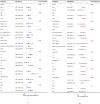Association of oxidative balance score with hyperuricemia and gout: NHANES 2009-2018
- PMID: 39558977
- PMCID: PMC11570265
- DOI: 10.3389/fendo.2024.1402369
Association of oxidative balance score with hyperuricemia and gout: NHANES 2009-2018
Abstract
Introduction: Oxidative stress plays a crucial role in the development and progression of hyperuricemia/gout. This study aims to explore the relationship between the Oxidative Balance Score (OBS) and hyperuricemia/gout.
Methods: The study utilized complete data from adult participants in the National Health and Nutrition Examination Survey (NHANES) spanning from 2009 to 2018. OBS, composed of scores for 20 dietary and lifestyle factors, served as the exposure variable. Multivariable linear regression model was applied to evaluate the association between OBS and uric acid (UA). Multivariable logistic regression, subgroup analyses, and restricted cubic spline (RCS) regression were conducted to explore the relationship between OBS and hyperuricemia/gout.
Results: A total of 18,998 participants were included. In the fully adjusted model, compared to the lowest quartile, the highest quartiles of OBS, dietary OBS, and lifestyle OBS were negatively correlated with UA (β=-0.31 (-0.36,-0.25), β=-0.18 (-0.24,-0.12), and β=-0.64 (-0.69,-0.59), respectively) and hyperuricemia (OR=0.63 (0.55,0.71), OR=0.76 (0.67,0.86), OR=0.37 (0.33,0.42), respectively). Moreover, the highest quartiles of OBS and lifestyle OBS exhibited a negative correlation with gout (OR=0.72(0.58,0.91), OR=0.54 (0.43,0.67), respectively). Subgroup analyses revealed differences in the negative association between OBS and hyperuricemia concerning hypertension (p for interaction =0.002) and diabetes (p for interaction= 0.004), while gender-related disparities were observed in the negative association between OBS and gout (p for interaction =0.008). RCS analysis demonstrated a linear negative association between hyperuricemia and OBS (p for non-linearity >0.05), while gout exhibited a non-linear negative association (p for non-linearity<0.05).
Conclusion: The study found that a higher OBS was associated with a decreased risk of developing hyperuricemia/gout, underscoring its potential in the prevention and management of these conditions.
Keywords: NHANES; antioxidants; gout; hyperuricemia; oxidative balance score; oxidative stress.
Copyright © 2024 He, Chen, Ma, Wang and Lin.
Conflict of interest statement
The authors declare that the research was conducted in the absence of any commercial or financial relationships that could be construed as a potential conflict of interest.
Figures




Similar articles
-
Associations of oxidative balance score with hyperuricemia and gout among American adults: a population-based study.Front Endocrinol (Lausanne). 2024 Jun 26;15:1354704. doi: 10.3389/fendo.2024.1354704. eCollection 2024. Front Endocrinol (Lausanne). 2024. PMID: 38988995 Free PMC article.
-
Association between oxidative balance score and serum uric acid and hyperuricemia: a population-based study from the NHANES (2011-2018).Front Endocrinol (Lausanne). 2024 Jun 20;15:1414075. doi: 10.3389/fendo.2024.1414075. eCollection 2024. Front Endocrinol (Lausanne). 2024. PMID: 38966221 Free PMC article.
-
Nonlinear relationship between oxidative balance score and hyperuricemia: analyses of NHANES 2007-2018.Nutr J. 2024 May 4;23(1):48. doi: 10.1186/s12937-024-00953-1. Nutr J. 2024. PMID: 38704549 Free PMC article.
-
Association between oxidative balance score and risk of gout: The NHANES cross-sectional study, 2007-2018.Int J Rheum Dis. 2024 Jul;27(7):e15255. doi: 10.1111/1756-185X.15255. Int J Rheum Dis. 2024. PMID: 38982881
-
Impact of alcohol consumption on hyperuricemia and gout: a systematic review and meta-analysis.Front Nutr. 2025 May 20;12:1588980. doi: 10.3389/fnut.2025.1588980. eCollection 2025. Front Nutr. 2025. PMID: 40463472 Free PMC article.
References
MeSH terms
Substances
LinkOut - more resources
Full Text Sources
Medical

